Owls are a fascinating group of birds known for their distinctive hooting calls. These nocturnal hunters found in a variety of habitats will use such vocalization to communicate.
There are 19 species of owls in North America; 7 of them are known to hoot. If you live in Europe, Asia, Africa, or Australia, don’t worry, we will also mention hooting owls from your continent.
From the majestic Great Horned Owls and Barred Owls to the tiny Flammulated Owls, these raptors will stun you with their hooting vocabularies.
Table of Contents
Owls That Hoot
1. Great Horned Owl

- Scientific Name: Bubo virginianus
- Length: 17-25 in
- Wingspan: 35-60 in
- Weight: 2.7-3.5 lb
With a wingspan of almost 5 feet, length of almost 2 feet, and weight of up to 3.5 pounds, great horned owls are among the largest owls found throughout North America.
These aggressive raptors have gray-brown plumage with a mottled pattern, long earlike tufts, and enormous and intimidating bright yellow eyes. Typically well-camouflaged, great horned owls are never easy to spot in the wild and can be instead more easily recognized by their hoots.
Great horned owls will often make low-pitched and loud hoots consisting of 4-5 syllables that sound like “ho-ho-hoo-hoo-hoo“. These owls hoot to warn intruders from entering their territories or to alert other owls that there’s a predator close. Occasionally, a mated pair might use a duet of hooting to communicate, with females having a higher pitch than males.
Great Horned Owl Call| Source: Bushman, CC BY-SA 3.0, via Wikimedia Commons
Generally speaking, great horned owls will hoot less frequently around February or March, at the start of their egg-laying season. Adult owls will also make different sounds, including whistles, barks, hisses, coos, screeches, etc.
2. Barred Owl
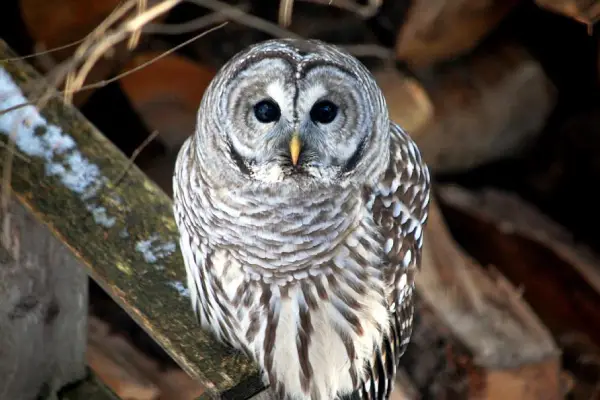
- Scientific Name: Strix varia
- Length: 16-25 in
- Wingspan: 38-49 in
- Weight: 1.3-2.5 lb
Known under several names such as northern barred owls and striped owls, barred owls are native to eastern North America. They are common around woods and swamps where they hunt for insects, small mammals, crayfish, and crabs.
These large birds with mottled brown and white plumage can be identified by their yellow beaks, absence of ear tufts, and large and dark brown, almost black eyes.
Barred owls are most known for their distinctive hooting call that consists of 8–9 notes and sounds like “who cooks for you, who cooks for you all”. These powerful calls can be heard almost half a mile away and have earned them the nickname “Old Eight-Hooters“.
Barred Owl Call | Source: Matthias Sirch, CC BY-SA 4.0, via Wikimedia Commons
As part of their mating ritual, pairs will often make a duet of hoots, cackles, caws, and gurgles. After they establish nests, barred owls become very territorial and aggressive – they will chase away intruders by hooting aggressively or attacking them with their sharp talons!
Fun Fact: Barred owls are also known as hoot owls!
3. Great Gray Owl
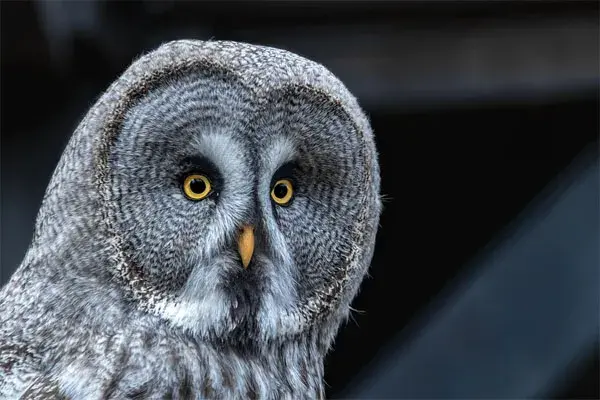
- Scientific Name: Strix nebulosa
- Length: 24-33 in
- Wingspan: 56-60 in
- Weight: 1.2-4 lb
Great gray owls are the largest species of owls in the world by length. They measure from 24 to 33 inches and are known under several names, including Phantoms of the North, bearded owls, sooty owls, etc.
Patterned with brown and white mottling, streaks, and barrings, great gray owls blend perfectly with the gray-brown bark of their conifer perch. They also have large yellow eyes on their large round heads.
These owls are extremely secretive and hard to find and birders often consider it a huge achievement to get a confirmed sighting. They inhabit Europe, Asia, and North America.
Great gray owls are most vocal during the breeding season with pairs making a low-pitched series of “hoos” that last between 6 and 8 seconds and have a 30-second pause between the calls. They will also make soft double hoots when protecting their territories or when humans feed them; females have higher-pitched voices than males.
Great Gray Owl Call
Great gray owls hoot and hunt at night or around dusk and dawn, mostly catching voles.
4. Snowy Owl
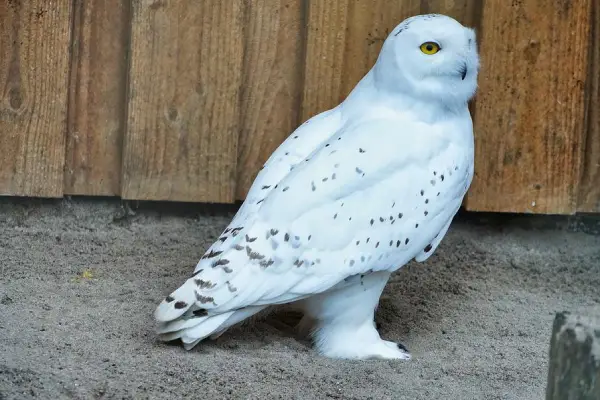
- Scientific Name: Bubo scandiacus
- Length: 21-28 in
- Wingspan: 45.7-72 in
- Weight: 2.9-6.5 lb
Snowy owls are enormous white birds of prey. They are the heaviest owls in North America and have a longer wingspan than any other owl found there.
Because of the cold weather in the Arctic regions they inhabit, snowy owls need good insulation; even their feet are covered with feathers! They are the only white owls in the world and males tend to be whiter than females; both have some black or brown markings on the body and wings and yellow eyes.
They are very vocal birds with over 15 different calls they mostly make from a perch; occasionally in flight.
Snowy owls hoot during the day and make low, powerful, and slightly rasping hoots consisting of 2-6 notes given in a row. They can be heard for miles and do that to communicate with other owls or to defend their territories or themselves.
Snowy Owl Call
Their favorite food is lemmings (small mouselike rodents) – they might hunt as much as 1,600 of those per year.
5. Spotted Owl
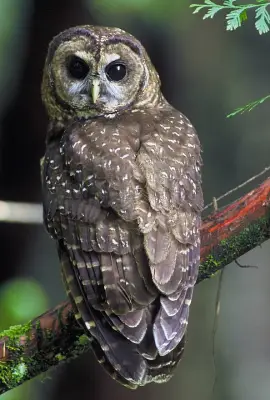
- Scientific Name: Strix occidentalis
- Length: 17 in
- Wingspan: 45 in
- Weight: 1.3 lb
Spotted owls are species of true owls. True owls or typical owls belong to the Strigidae family and are one of the two generally accepted owl families, together with barn owls.
These nocturnal birds are found in western parts of North America. There are 3 subspecies:
- Northern spotted owl (S. o. caurina)
- Mexican spotted owl (S. o. lucida)
- California spotted owl (S. o. occidentalis)
They prefer the coolest parts of the forest, nesting in cliffs at elevations ranging from 5,000 to 7,000 feet. Identify spotted owls by their chestnut brown plumage with white and brown spots, white bands on the tails, and dark eyes.
Spotted owls are vocal species that can be most often heard at sunset, early evening, predawn, and dawn.
Out of 13 different hoots, barks, and whistles, their most famous call consists of a series of 4 deep hoots with the middle two notes closest together. Females have higher voices than males and both sexes make the calls to defend their territory.
Spotted Owl Call
Due to habitat loss and competition with other owls, their population has been on the decline – the International Union for Conservation of Nature (IUCN) listed spotted owls as Near Threatened species.
They are just one of the 19 night birds found in Texas; read more about the other species here.
6. Flammulated Owl

- Scientific Name: Psiloscops flammeolus
- Length: 6 in
- Wingspan: 14 in
- Weight: 1.8-2.3 oz
Flammulated owls are unique among small owls due to their completely dark eyes and low hoots.
These tiny reddish birds are just 6 inches long and span around 14 inches across the wings – such large wings allow them to quickly move from one tree to the other. Females are longer and bigger than males – the species were named after the flame-like markings on their faces.
Because of the long trachea (windpipe), flammulated owls make low-pitched single or double hoots that sound like much larger owls made them. The Cornell Lab of Ornithology describes their repeated hoots as “ventriloquial” since it is almost impossible to locate the bird from the sound.
Flammulated Owl Call
Flammulated owls are migratory birds found in western parts of the USA, southern parts of British Columbia, central Mexico, and Central America (during winter). Strictly nocturnal, they almost entirely feed on insects and some shrews, and other rodents.
7. Long-eared Owl
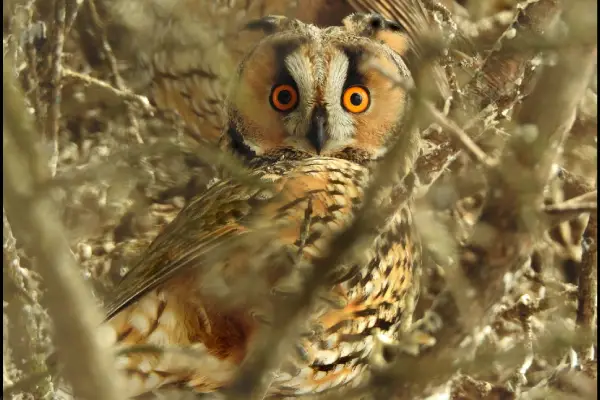
- Scientific Name: Asio otus
- Length: 12-16 in
- Wingspan: 34-40 in
- Weight: 9-15 oz
Long-eared owls are found throughout most of North America, Europe, Asia, and Africa.
Also known as northern long-eared owls, lesser horned owls, or cat owls, these medium-sized owls with long ear tufts and big eyes inhabit brushy thickets, conifer groves, and semi-open areas. North American long-eared owls have yellow eyes, while their Eurasian counterparts have reddish ones.
Although silent most of the year, male long-eared owls can be extremely vocal in their breeding season and emit hoots that can be heard from over half a mile away during the night.
People describe their hoots as the sound of blowing air over a very large bottle; male long-eared owls will make a series of 10-200 “whoo” notes given every 2-4 seconds. The species will also make whistles, whines, shrieks, and cat-like meows.
Long-eared Owl Call | Source: Alexander Kurthy, CC BY-SA 4.0, via Wikimedia Commons
They are also one of the only 12 owl species that live in Japan.
8. Tawny Owl
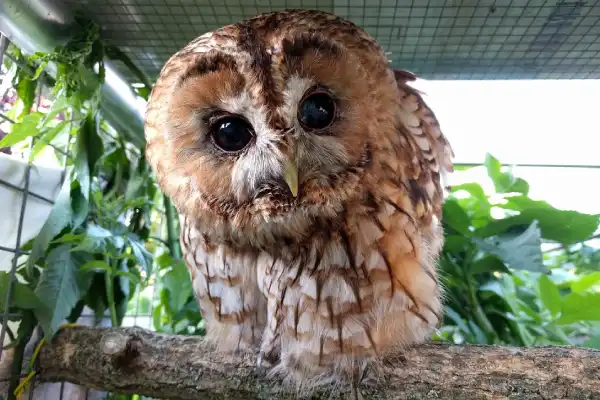
- Scientific Name: Strix aluco
- Length: 15-18 in
- Wingspan: 32-41 in
- Weight: 0.8-1.7 lb
Tawny owls are also known as brown owls and can be found in Europe and Asia. These stocky raptors with rounded heads, no ear tufts, and dark facial disks come in two colors: one is rufous-brown and the other is grayish-brown.
They are very territorial species and when young birds leave the nests, if they can’t find a territory to claim of their own, they will often die of starvation.
Tawny owls are nocturnal birds of prey that use hoots as their main way of communication. A study from 2020 discovered that they mostly hoot during the night, from 5 PM to 6 AM. Males usually make such calls to defend their territory.
Tawny Owl Call | Source: Chris Taklis, CC BY-SA 4.0, via Wikimedia Commons
Due to their activity at night and haunting “hooo” calls, people consider them to be an omen of bad luck.
9. Australian Boobook
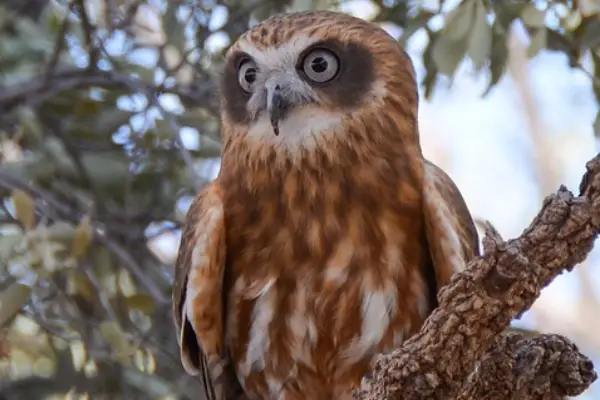
- Scientific Name: Ninox boobook
- Length: 10.5-14 in
- Wingspan: 28-33.5 in
- Weight: 5.1-12.7 oz
Australian boobooks are also known as mopokes. These brownish owls with dark “glasses” around their eyes are the smallest owls in Australia.
They inhabit different areas, ranging from forests and open woodlands to scrublands and semidesert areas.
Australian boobooks have mostly dark-brown plumage with pale spots and grey-green or green-yellow eyes. Although mostly nocturnal, Australian boobooks can be sometimes spotted around dusk or dawn, hunting mice, insects, and small birds.
You are more likely to hear them, as their powerful calls can be heard more than half a mile away.
Australian boobooks will make two-note hoot calls with the first note higher in pitch than the second. They hoot from sunset to dawn to attract females, when they bring food to their mates, or as contact calls.
Australian Boobook Call | Source: James Ray, CC BY-SA 4.0, via Wikimedia Commons
They might also make repetitive croaking or grunting sounds as a response to other boobooks hooting.
10. Ural Owl

- Scientific Name: Strix uralensis
- Length: 19.7-24.4 in
- Wingspan: 48.8-52.7 in
- Weight: 1-3.2 lb
Ural owls are widespread species that range from Scandinavia through Russia to Japan. These large owls can be identified by their small dark eyes, bright yellow beaks, pale gray to dark brown plumage, and lack of ear tufts.
Ural owls inhabit deciduous or mixed forests and woodlands with clearings where they feed on voles, shrews, rats, mice, birds, insects, and lizards. They are nocturnal and hunt at night, detecting their prey by sound.
Ural owls are monogamous and stay together for years, often for life. To strengthen their bond, males will sing and provide prey to females. Males also make deep, resonating hoots while the females emit higher, hoarser notes. Ural owls hoot during the night, starting around 10 PM and more intensely around 2 AM.
Ural Owl Call | Source: Alexander Kurthy, CC BY-SA 4.0, via Wikimedia Commons
11. Eurasian Eagle-owl

- Scientific Name: Bubo bubo
- Length: 22-30 in
- Wingspan: 51.5-74 in
- Weight: 2.6-10.1 lb
Eurasian eagle-owls are huge and powerful owls found in Europe and Asia, in various habitats ranging from forests to rocky canyons. They are also called the Uhu.
These raptors have very pronounced ear tufts, mottled brownish feathers, and streaked breasts – like most owls, there are no color differences between the sexes. Eurasian eagle-owls also have pumpkin-orange eyes that make them one of the most striking owls in the world.
To communicate their moods and needs, these large raptors will make clicks, chirps, growls, or beak clacks. As part of their courtship ritual, males will bow and hoot loudly at the females. Pairs are vocal and will often sing in a duet, exchanging a series of deep and high-pitched hoots.
Eurasian Eagle-owl Call | Source: Mirko Tomasi, CC BY-SA 4.0, via Wikimedia Commons
In the wild, Eurasian eagle-owls will live up to 20 years – in captivity, they can reach 60!
12. Spectacled Owl

- Scientific Name: Pulsatrix perspicillata
- Length: 16-20.6 in
- Wingspan: 33 in
- Weight: 1-2.7 lb
Spectacled owls are large and unmistakable birds found in Central and South America. They are common in humid evergreen forests, often staying hidden in shady spots.
Spectacled owls are with dark brown bodies and very white to yellow-ochre-colored bellies – they also have light lines around their large bright orange-yellow eyes that look like “spectacles”.
Most vocal on calm, moonlit nights, spectacled owls will make calls consisting of a series of deep hoots that is described as “a sheet of metal being flexed quickly” or “a hammer hitting a hollow tree”.
Spectacled Owl Call | Source: Niels Krabbe, CC BY-SA 4.0, via Wikimedia Commons
Males will sing to advertise their territory, usually high in trees. Females will make similar songs but with a higher pitch; pairs will often sing in duets.
13. Cape Eagle-owl
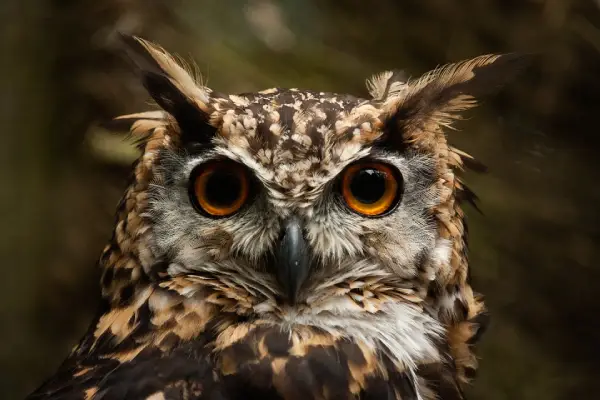
- Scientific Name: Bubo capensis
- Length: 18-24 in
- Wingspan: 48 in
- Weight: 2-4 lb
Cape eagle-owls are large owls with strong-looking builds found in South Africa where they inhabit rocky terrains, mostly mountains. They resemble spotted eagle-owls and can be identified by their dark brown plumage, prominent ear tufts, and striking yellowish-orange eyes.
Cape eagle-owls have a song that consists of a strong and explosive hoot that is followed by a weaker “bowh-hu“. Females have similar voices to males, only higher pitched; pairs will occasionally sing in a duet.
Cape eagle-owl Call | Source: David Watts , CC BY 4.0, via Wikimedia Commons
14. Ryukyu Scops-owl
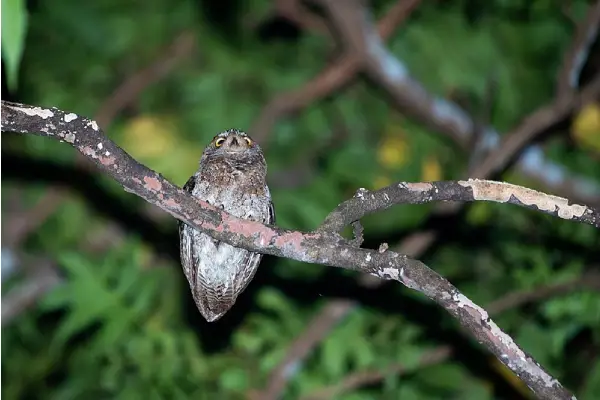
- Scientific Name: Otus elegans
- Length: 7.8 in
- Wingspan: n/a
- Weight: 2.5-4.4 oz
Ryukyu scops-owls, also known as elegant scops-owls, live on the Ryukyu Islands in Japan, Lanyu Island in Taiwan, and the Batanes and Babuyan Islands in the Philippines. These small birds of prey have brownish plumage, short ear tufts, yellow eyes, and pale faces bordered with black.
Ryuku scops-owls are common in tropical and subtropical evergreen forests but might be hard to spot – they are best identified by their long series of hiccuping hoots.
Ryuku scops-owl call
15. Oriental Bay Owl
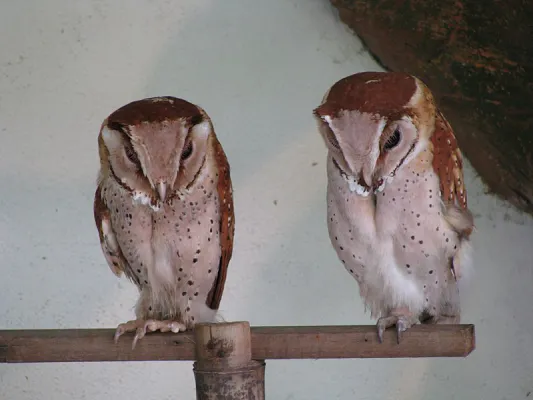
- Scientific Name: Phodilus badius
- Length: 10.1 in
- Wingspan: 16.1 in
- Weight: 19.8 oz
These unique-looking birds of prey are common in Southeast Asia and parts of India. Oriental bay owls are brown above, creamy-gray above, and have highly angular heads and large dark eyes.
Due to their small size and elusive nature, they might be hard to spot in forests and mangroves; the best is to identify them for their calls. Oriental bay owls will hoot, scream, and make high-pitched whistle songs.
Oriental Bay Owl Call
Summary
This concludes our list of owls that hoot. Examples include great horned owls, spotted owls, barred owls, snowy owls, Eurasian eagle owls, and many others.
Hopefully next time you hear these, you will recognize any of them with ease!